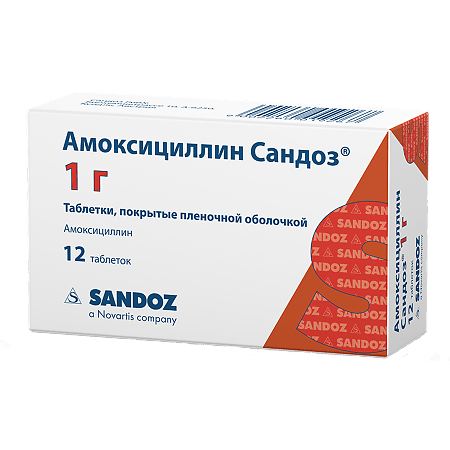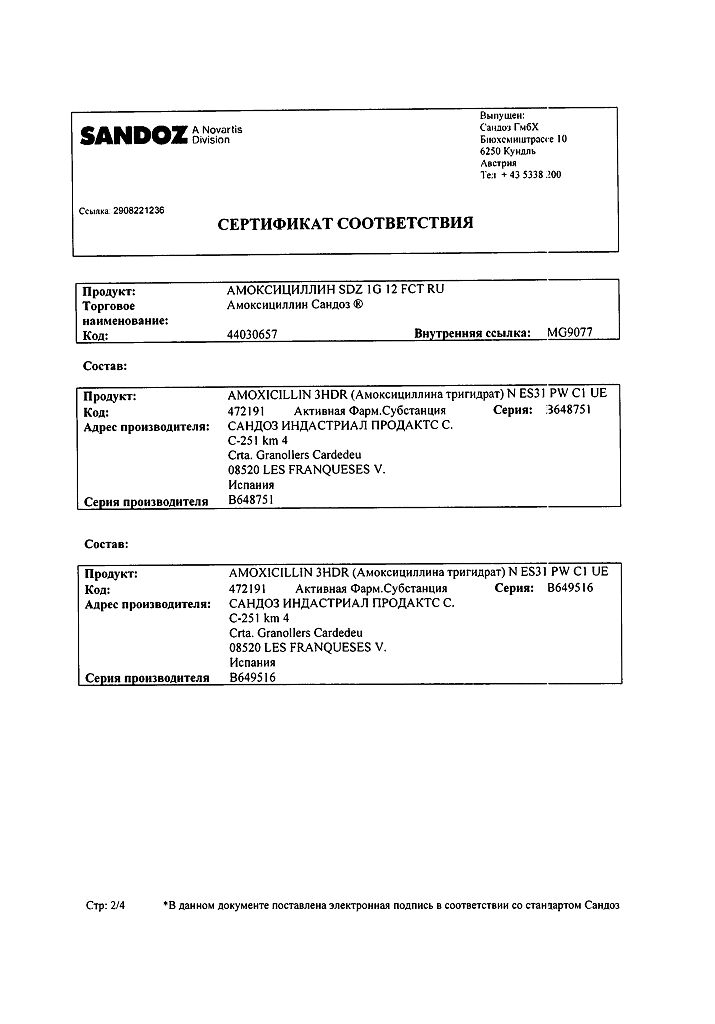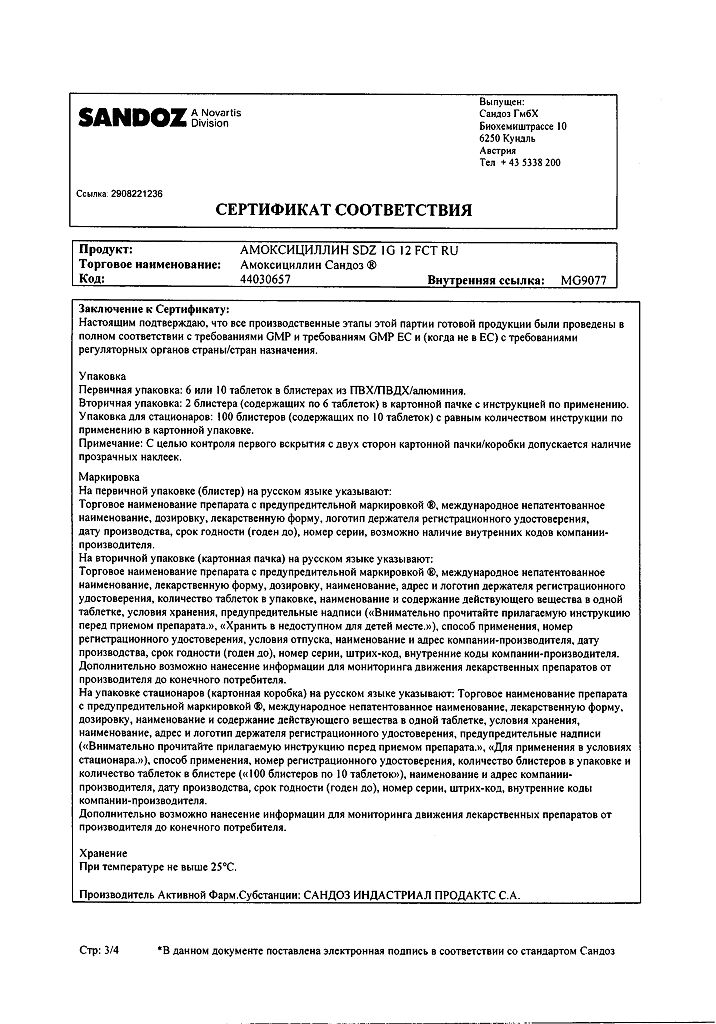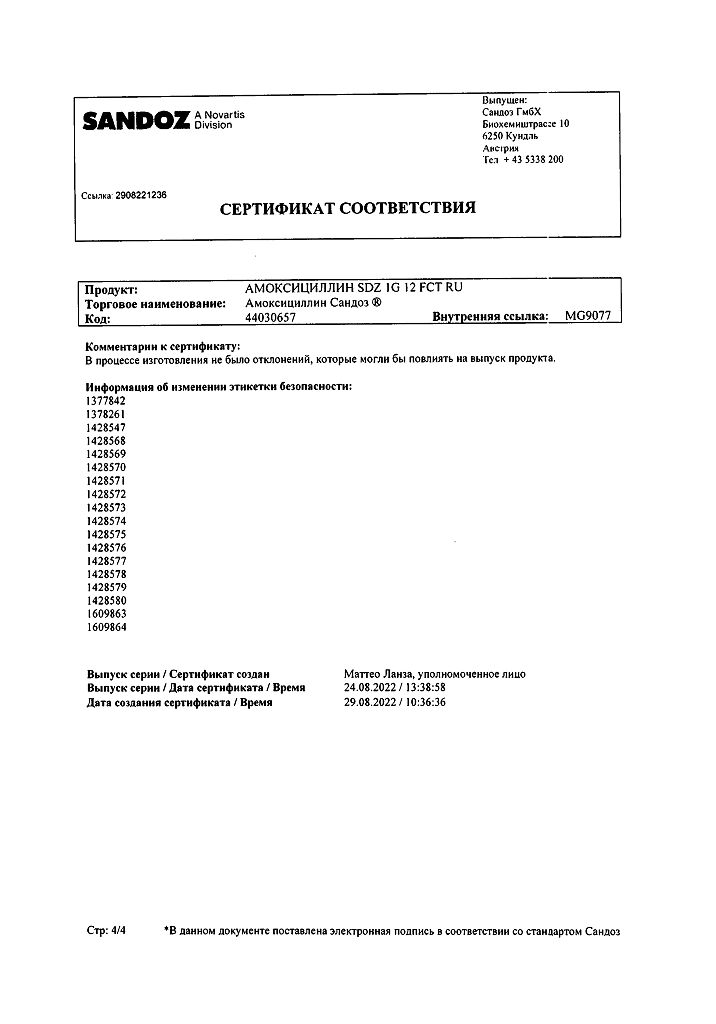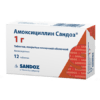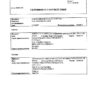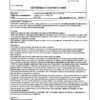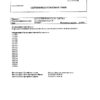No products in the cart.
Amoxicillin Sandoz, 1 g 12 pcs
€5.00 €4.89
Out of stock
(E-mail when Stock is available)
Description
Pharmacological action – broad spectrum antibacterial.
Pharmacodynamics
Amoxicillin is a semi-synthetic penicillin with bactericidal action. The mechanism of bactericidal action of amoxicillin is associated with damage to the cell membrane of bacteria that are in the breeding stage. Amoxicillin specifically inhibits bacterial cell membrane enzymes (peptidoglycans), resulting in their lysis and death.
Active against:
Gram-positive aerobic bacteria – Bacillus anthracis, Corynebacterium spp. (except Corynebacterium jeikeium), Enterococcus faecalis, Listeria monocytogenes, Streptococcus spp. (including Streptococcus pneumoniae), Staphylococcus spp. (except penicillinase-producing strains).
Gram-negative aerobic bacteria – Borrelia sp., Escherichia coli, Haemophilus spp., Helicobacter pylori, Leptospira spp., Neisseria spp., Proteus mirabilis, Salmonella spp., Shigella spp., Treponema spp., Campylobacter.
The others are Chlamydia spp.
Anaerobic bacteria – Bacteroides melaninogenicus, Clostridium spp., Fusobacterium spp., Peptostreptococcus spp.
Inactive against:
Gram-positive aerobic bacteria Staphylococcus (β-lactamase-producing strains).
Gram-negative aerobic bacteria – Acinetobacter spp., Citrobacter spp., Enterobacter spp., Klebsiella spp., Moraxella catarrhalis, Proteus spp., Providencia spp., Pseudomonas spp., Serratia spp.
Anaerobic bacteria – Bacteroides spp.
Others – Mycoplasma spp., Rickettsia spp.
Pharmacokinetics
The absolute bioavailability of amoxicillin depends on the dose and is from 75 to 90%. The presence of food has no effect on absorption of the drug. As a result of oral administration of amoxicillin in a single dose of 500 mg, the drug concentration in plasma is 6-11 mg/l. After oral administration, Cmax in plasma is reached after 1-2 hours.
From 15 to 25% of amoxicillin is bound to plasma proteins. The drug rapidly penetrates into lung tissue, bronchial secretion, middle ear fluid, bile and urine. In the absence of inflammation of the meninges amoxicillin penetrates into the cerebrospinal fluid in small amounts. With inflammation of the meninges the drug concentrations in the cerebrospinal fluid may be 20% of its concentration in blood plasma. Amoxicillin penetrates through the placenta and is detected in small amounts in breast milk.
Up to 25% of the administered dose is metabolized to form inactive penicillic acid.
About 60-80% of amoxicillin is excreted unchanged by the kidneys within 6-8 hours after drug administration. A small amount of the drug is excreted with the bile. T1/2 is 1-1.5 h. In patients with terminal renal failure T1/2 varies from 5 to 20 hours. The drug is excreted with hemodialysis.
Indications
Indications
Amoxicillin is indicated for infectious and inflammatory diseases caused by bacteria that are not resistant to the drug:
infectious diseases of the upper and lower respiratory tract and ENT organs (angina, acute otitis media, pharyngitis, bronchitis, pneumonia, lung abscess);
infectious diseases of the genitourinary system (urethritis, pyelonephritis, pyelitis, chronic bacterial prostatitis, epididymitis; cystitis, adnexitis, septic abortion, endometritis, etc.);
gastrointestinal infections: bacterial enteritis. Combination therapy may be required for infections caused by anaerobic microorganisms;
infectious and inflammatory diseases of the biliary tract (cholangitis, cholecystitis);
eradication of Helicobacter pylori (in combination with proton pump inhibitors, clarithromycin or metronidazole);
skin and soft tissue infections;
leptospirosis, listeriosis, Lyme disease (borreliosis);
endocarditis (including prevention of endocarditis during dental procedures).
Pharmacological effect
Pharmacological effect
Pharmacological action – broad spectrum antibacterial.
Pharmacodynamics
Amoxicillin is a semi-synthetic penicillin that has a bactericidal effect. The mechanism of the bactericidal action of amoxicillin is associated with damage to the cell membrane of bacteria that are in the reproduction stage. Amoxicillin specifically inhibits the enzymes of bacterial cell membranes (peptidoglycans), resulting in their lysis and death.
Active regarding:
Gram-positive aerobic bacteria – Bacillus anthracis, Corynebacterium spp. (except Corynebacterium jeikeium), Enterococcus faecalis, Listeria monocytogenes, Streptococcus spp. (including Streptococcus pneumoniae), Staphylococcus spp. (except for penicillinase-producing strains).
Gram-negative aerobic bacteria – Borrelia sp., Escherichia coli, Haemophilus spp., Helicobacter pylori, Leptospira spp., Neisseria spp., Proteus mirabilis, Salmonella spp., Shigella spp., Treponema spp., Campylobacter.
Others – Chlamydia spp.
Anaerobic bacteria – Bacteroides melaninogenicus, Clostridium spp., Fusobacterium spp., Peptostreptococcus spp.
Inactive regarding:
Gram-positive aerobic bacteria Staphylococcus (β-lactamase-producing strains).
Gram-negative aerobic bacteria – Acinetobacter spp., Citrobacter spp., Enterobacter spp., Klebsiella spp., Moraxella catarrhalis, Proteus spp., Providencia spp., Pseudomonas spp., Serratia spp.
Anaerobic bacteria – Bacteroides spp.
Others – Mycoplasma spp., Rickettsia spp.
Pharmacokinetics
The absolute bioavailability of amoxicillin depends on the dose and ranges from 75 to 90%. The presence of food does not affect the absorption of the drug. As a result of oral administration of amoxicillin in a single dose of 500 mg, the concentration of the drug in plasma is 6–11 mg/l. After oral administration, Cmax in plasma is achieved within 1–2 hours.
From 15 to 25% of amoxicillin is bound to plasma proteins. The drug quickly penetrates into lung tissue, bronchial secretions, middle ear fluid, bile and urine. In the absence of inflammation of the meninges, amoxicillin penetrates into the cerebrospinal fluid in small quantities. In case of inflammation of the meninges, the concentration of the drug in the cerebrospinal fluid may be 20% of its concentration in the blood plasma. Amoxicillin crosses the placenta and is found in small quantities in breast milk.
Up to 25% of the administered dose is metabolized to form inactive penicillic acid.
About 60–80% of amoxicillin is excreted unchanged by the kidneys within 6–8 hours after taking the drug. A small amount of the drug is excreted in the bile. T1/2 is 1–1.5 hours. In patients with end-stage renal failure, T1/2 varies from 5 to 20 hours. The drug is eliminated by hemodialysis.
Special instructions
Special instructions
Before prescribing Amoxicillin Sandoz®, you must make sure that the strains of microorganisms that cause the infectious disease are sensitive to the drug.
In case of severe infectious and inflammatory processes of the gastrointestinal tract, accompanied by prolonged diarrhea or nausea, it is not recommended to take Amoxicillin Sandoz® orally due to possible low absorption of the drug.
When treating mild diarrhea during a course of treatment, antidiarrheal drugs that reduce intestinal motility should be avoided; You can use kaolin- or attapulgite-containing antidiarrheal drugs. If diarrhea is severe, consult a doctor.
If severe persistent diarrhea develops, the development of pseudomembranous colitis (caused by Clostridium difficile) should be excluded. In this case, Amoxicillin Sandoz® should be discontinued and appropriate treatment prescribed. In this case, drugs that slow down gastrointestinal motility are contraindicated.
During a course of treatment, it is necessary to monitor the state of the function of the hematopoietic organs, liver and kidneys.
It is possible that superinfection may develop due to the growth of microflora that is insensitive to it, which requires a corresponding change in antibacterial therapy.
In patients who are hypersensitive to penicillins, cross-allergic reactions with other beta-lactam antibiotics are possible.
Treatment must continue for another 48–72 hours after the disappearance of clinical signs of the disease.
When using estrogen-containing oral contraceptives and amoxicillin simultaneously, other or additional methods of contraception should be used.
Amoxicillin Sandoz® is not recommended for the treatment of acute respiratory viral infectious diseases due to low effectiveness.
Particular caution is recommended for patients with allergic diathesis or bronchial asthma, or a history of gastrointestinal diseases (in particular, colitis caused by antibiotic treatment).
When taking Amoxicillin Sandoz® for a long time, nystatin, levorin or other antifungal drugs should be prescribed simultaneously.
It is not recommended to consume ethanol during treatment.
The use of Amoxicillin Sandoz® does not affect the results of the enzymatic test for glycosuria, however, false-positive results of a urine test for glucose are possible.
While taking Amoxicillin Sandoz®, it is recommended to drink plenty of fluids to prevent the formation of amoxicillin crystals in the urine.
Impact on the ability to drive vehicles and perform other activities that require concentration and speed of psychomotor reactions
Due to the potential for side effects such as drowsiness, headache and confusion, caution should be exercised when engaging in potentially hazardous activities that require increased concentration and psychomotor speed.
Active ingredient
Active ingredient
Amoxicillin
Composition
Composition
1 tablet 1.0 g contains:
Core:
Active ingredient: amoxicillin (in the form of amoxicillin trihydrate) 1000.0 mg (1148.0 mg).
Excipients: magnesium stearate 10.0 mg, povidone 25.0 mg, sodium carboxymethyl starch (type A) 40.0 mg, microcrystalline cellulose 121 mg.
Film coating: titanium dioxide 0.68 mg, talc 1.07 mg, hypromellose 4.25 mg.
Pregnancy
Pregnancy
Animal studies have shown that amoxicillin does not have embryotoxic, teratogenic or mutagenic effects on the fetus. However, adequate and controlled studies on the use of amoxicillin in pregnant women have not been conducted, so the use of amoxicillin during pregnancy is possible only if the expected benefit to the mother outweighs the potential risk to the fetus.
The drug is excreted in breast milk, therefore, when treating with amoxicillin during lactation, it is necessary to decide on stopping breastfeeding, since diarrhea and/or fungal colonization of the mucous membrane, as well as sensitization to beta-lactam antibiotics in a nursing infant, may develop.
Contraindications
Contraindications
hypersensitivity to penicillin and other components of the drug;
hypersensitivity to other beta-lactam antibiotics, such as cephalosporins, carbopenems (possibility of cross-reaction);
children under 3 years of age (for this dosage form).
The drug should be used with caution in patients with impaired renal function; severe digestive disorders accompanied by constant vomiting and diarrhea; allergic diathesis; asthma; hay fever; with viral infections; with acute lymphoblastic leukemia; infectious mononucleosis (due to an increased risk of erythematous skin rash); in children over three years of age.
Side Effects
Side Effects
The frequency of side effects is presented in accordance with the following gradation: very common – more than 10%; frequent – from 1 to 10%; infrequent – from 0.1 to 1%; rare – from 0.01 to 0.1%; very rare – less than 0.01%.
From the cardiovascular system: frequent – tachycardia, phlebitis; rare – decreased blood pressure; very rare – prolongation of the QT interval.
From the blood and lymphatic system: frequent – eosinophilia, leukopenia; rare – neutropenia, thrombocytopenia, agranulocytosis; very rare – anemia (including hemolytic), thrombocytopenic purpura, pancytopenia.
From the nervous system: frequent – drowsiness, headache, dizziness; rare – nervousness, agitation, anxiety, ataxia, behavior changes, peripheral neuropathy, anxiety, sleep disturbance, depression, paresthesia, tremor, confusion, convulsions; very rare – hyperesthesia, impaired vision, smell and tactile sensitivity, hallucinations.
From the genitourinary system: rare – interstitial nephritis, increased concentration of creatinine in the blood serum.
From the gastrointestinal tract and liver: dysbacteriosis, changes in taste, stomatitis, glossitis; frequent – nausea, diarrhea, increased liver parameters (ALT, AST, alkaline phosphatase, γ-glutamyltransferase), increased concentration of bilirubin in the blood serum; rare – vomiting, dyspepsia, epigastric pain, hepatitis, cholestatic jaundice; very rare – acute liver failure, diarrhea mixed with blood, pseudomembranous colitis, the appearance of a black color of the tongue.
From the musculoskeletal system: rare – arthralgia, myalgia, tendon diseases including tendonitis; very rare – tendon rupture (possible bilaterally and 48 hours after the start of treatment), muscle weakness, rhabdomyolysis.
Skin disorders: frequent – pruritis, rash; rare – urticaria; very rare – photosensitivity, swelling of the skin and mucous membranes, malignant exudative erythema (Stevens-Johnson syndrome), toxic epidermal necrolysis (Lyell’s syndrome).
From the endocrine system: rare – anorexia; very rare – hypoglycemia, especially in patients with diabetes.
From the respiratory system: rare – bronchospasm, dyspnea; very rare – allergic pneumonitis.
General: rare – general weakness; very rare – increased body temperature.
Other: difficulty breathing, vaginal candidiasis; rare – superinfection (especially in patients with chronic diseases or reduced body resistance), reactions similar to serum sickness; isolated cases – anaphylactic shock.
Interaction
Interaction
The absorption time of digoxin may increase during therapy with Amoxicillin Sandoz®.
Probenecid reduces the excretion of amoxicillin by the kidneys and increases the concentration of amoxicillin in bile and blood.
The simultaneous use of amoxicillin and other bacteriostatic drugs (macrolides, tetracyclines, sulfonamides, chloramphenicols) should be avoided due to the possibility of developing antagonism. With the simultaneous use of aminoglycosides and amoxicillin, a synergistic effect may develop.
The simultaneous use of amoxicillin and disulfiram is not recommended.
With the simultaneous use of methotrexate and amoxicillin, an increase in the toxicity of the former is possible, probably due to the competitive inhibition of renal tubular secretion of methotrexate by amoxicillin.
Antacids, glucosamine, laxatives, food, aminoglycosides slow down and reduce absorption, while ascorbic acid increases the absorption of amoxicillin.
Increases the effectiveness of indirect anticoagulants (suppressing intestinal microflora, reduces the synthesis of vitamin K and the prothrombin index); reduces the effectiveness of estrogen-containing oral contraceptives; medications, during the metabolism of which para-aminobenzoic acid (PABA) is formed, ethinyl estradiol preparations – the risk of developing “breakthrough” bleeding.
Diuretics, allopurinol, oxyphenbutazone, phenylbutazone, non-steroidal anti-inflammatory drugs and other drugs that block tubular secretion increase the concentration of amoxicillin in the blood.
Allopurinol increases the risk of developing skin rashes.
Overdose
Overdose
Symptoms: nausea, vomiting, diarrhea, water and electrolyte imbalance, nephrotoxicity, crystalluria, epileptic seizures.
Treatment: taking activated carbon, symptomatic therapy, correction of water-electrolyte imbalance, hemodialysis is possible.
Storage conditions
Storage conditions
Store in a dry place, protected from light, at room temperature.
Shelf life
Shelf life
4 years. Do not use after the expiration date stated on the package.
Manufacturer
Manufacturer
Sandoz GmbH, Austria
Additional information
| Shelf life | 4 years. Do not use after the expiration date stated on the package. |
|---|---|
| Conditions of storage | Store in a dry, light-protected place at room temperature. |
| Manufacturer | Sandoz GmbH, Austria |
| Medication form | pills |
| Brand | Sandoz GmbH |
Other forms…
Related products
Buy Amoxicillin Sandoz, 1 g 12 pcs with delivery to USA, UK, Europe and over 120 other countries.

